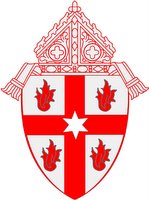 Today the Congregation for the Doctrine of the Faith issued a document meant to continue clarifying a phrase from the Second Vatican Council which stated that the fullness of the faith "subsisted in the Catholic Church." You can imagine that this phrase draws some "dialogue" from those who are taken up in the relativist view that all churches are the same.
Today the Congregation for the Doctrine of the Faith issued a document meant to continue clarifying a phrase from the Second Vatican Council which stated that the fullness of the faith "subsisted in the Catholic Church." You can imagine that this phrase draws some "dialogue" from those who are taken up in the relativist view that all churches are the same.The document does not present any new teaching but simply restates what the Church has always taught about itself. In the Catholic faith resides the church as it was intended by Christ.
Mainly the five questions break down into two subcategories: what does the Council mean by "subsist in" and what does the council mean by "church"?
In summary, one could understand it in this way, there are truths and means of sanctification found outside of the structure of the Catholic Church but ultimately those belong to the Church. In addition, the fullness of these ways and means can all be found within the Church. As to the word "Church" itself, only those communions which have sacraments and apostolic succession can be called churches because they contain constitutive elements of a "church." They contain priesthood and eucharist. This means that only the Catholic Church and those churches in the East can claim to be churches. Associations and communions formed out of the Reformation, because they do not have apostolic succession, can be called Christian in as far as they hold the doctrines of the Incarnation and the Trinity, yet because they are not in the succession of the Apostles they cannot be called Churches.
The Congregation was quick to point out that this is not a pull back from attempts at ecumenism, nor is it a change in her policy toward other faiths, only, to be authentic in our work toward eventual communion we must be clear about our identity as the Church founded by Christ.
This is a well documented and developing story, especially as the media gets a hold of this and starts twisting it. My good friend Thomas over at American Papist has done a great job covering the story and so I'll direct you to him here.
You can find the document here
and an unofficial english translation of the accompanying commentary here (scroll down a bit)








No comments:
Post a Comment